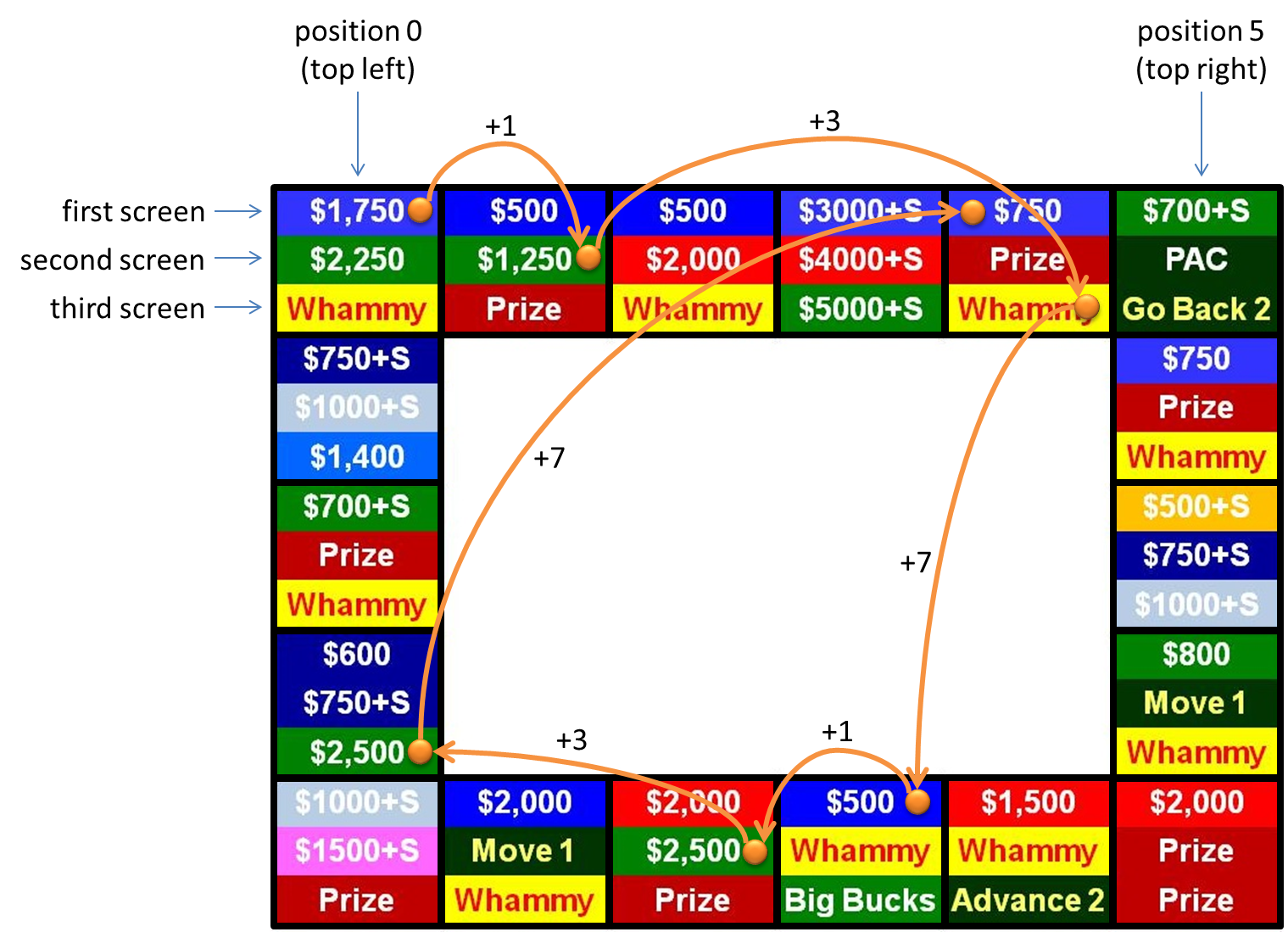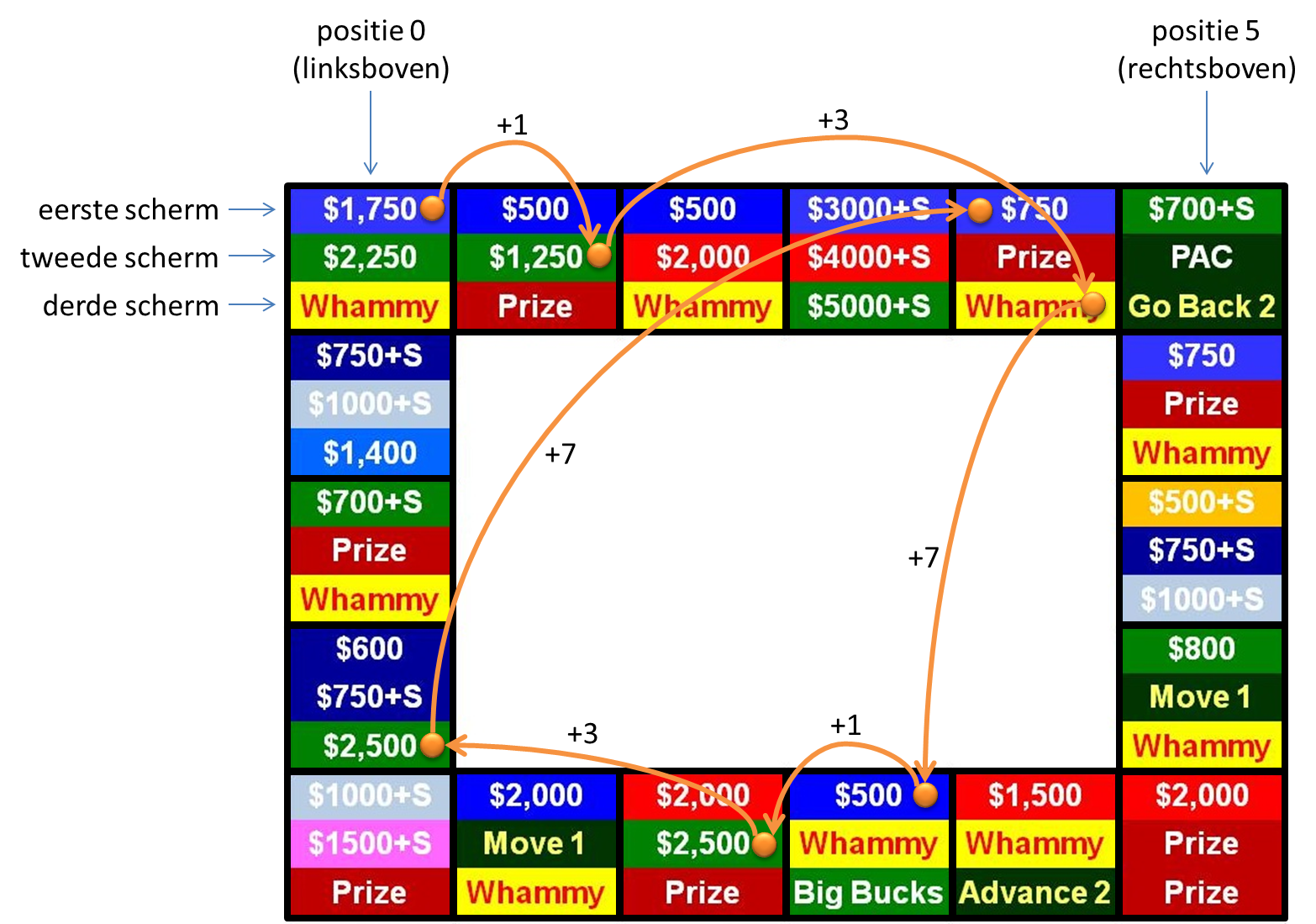PROG0538 - Press Your Luck
The audience was stunned when contestant Michael Larson won $110.237 on Press Your Luck in 1984. Easily the largest one-day total ever won on a game show to that date. As lights flashed randomly on the Big Board — the name given to the eighteen-square gameboard used in the show — somehow Larson was consistently able to stop on squares that led to cash and additional play, and avoid the "whammy" that would bankrupt him.
It turned out that the light indicator wasn't random. In studying the game at home, Larson had discovered that it followed five recognizable patterns. After memorizing these he could always be sure of landing on winning squares.
CBS producers divined the scheme, but they could find no cause to disqualify Larson, as he had broken no rules. They paid him his money, fixed the board, and established a maximum sum that future contestants could win. Larson may have congratulated himself, but he didn't get to enjoy his winnings — he lost the money in bad real estate investments and died of throat cancer at age 49.
Assignment
Below is an example configuration of the Big Board, the gameboard used in the television show Press Your Luck. The board consisted of $p$ squares (in the example $p = 18$) arranged in a rectangle, each of which displayed one of $s$ screens (in the example $s = 3$). If a player took turn, a fast cycle was initiated where at each step all squares displayed the next screen and a random square lit up. The player could stop the cycle by hitting his buzzer, which either won him the price that was shown on the screen marked by the randomizer light or made him loose al his money if he hit a screen marked with the whammy.
However, Larson had discovered a certain regularity in the apparently random behaviour of the gameboard. Each cycle turned out to be completely determined by a pattern that was composed of a sequence of positive integers and a square that was lit at the start of the cycle. At each step in the cycle, the gameboard is modified in two ways, that work completely independent of each other:
- The next square that is lit is determined by selecting the next integer $m$ from the pattern (starting at the first number, and returning to the first number after the last number), and moving clockwise to the screen that is $m$ positions upstream on the gameboard. The rectangular configuration of the gameboard causes the last square to be followed by the first square.
- At the start of a cycle, each square shows its first screen. Each step of the cycle switches all squares to their next screen from the sequence of $s$ screens, where the last screen is followed again by the first screen from the sequence.
The above figure illustrates this procedure with a cycle that uses the pattern [1, 3, 7] and starts at the square in the top left-hand of the gameboard. At the start of the cycle, the square in the top left-hand of the gameboard displays the screen containing $1750, the square to the right displays the screen containing $500, and so on. In the first step the randomizer light moves ahead 1 square clockwise through the rectangular board, and each square displays its second screen. If we would hit the buzzer at this point in time, the screen containing $1250 would be lit. In the second stap the randomizer light moves ahead 3 squares clockwise through the rectangular board, and the third screen containing whammy is lit. In the next step the randomizer light moves ahead 7 squares clockwise through the rectangular board, and the first screen displaying $500 is lit (during the previous step, each square displayed the last of its three screens). In the next step the randomizer light again moves ahead 1 square clockwise through the rectangular board (after the last integer from the pattern has been used, we continue with the first integer), and the second screen containing $2500 is lit. The figure continues to show the next two steps from the cycle. Your task:
- Write a function board that takes a sequence (a list or a tuple) of strings. This sequence of strings represents the prices (or Whammies) that are used to configure a Big Board with $s \in \mathbb{N}_0$ screens per square. The value $s$ can be passed to the second optional parameter screens (default value: 1). The function must return a list of squares, where each square is represented as a list that is filled with the next $s$ strings from the given sequence of strings. Each square thus represents a sequence of screens containing prices that are displayed round robin at the position of that square.
- Use the function board to write a function price. The function must return the price (string) that is lit up on the gameboard after it has cycled a given number of steps using a given pattern and a given starting position. The gameboard, the number of steps, the pattern and the starting position are determined by the values passed to the mandatory and optional parameters of the function:
- pattern (mandatory): sequence (list or tuple) of integers $\in \mathbb{N}_0$ that describes the pattern
- steps (mandatory): integer $\in \mathbb{N}_0$ that indicates the number of steps
- prices (mandatory): sequence (list or tuple) of strings that describes the gamebord (see function board)
- start (optional; default value: 0): integer $\in \mathbb{N}_0$ that indicates the position of the square where the cycle starts; squares are indexed clockwise, starting at the square in the top left-hand corner that is at position 0
- screens (optional; default value: 1): integer $\in \mathbb{N}_0$ that indicates the number of screens per square (see function board)
Both functions must raise an AssertionError with the message invalid board, in case the number of prices in the given sequence of strings is not a multiple of $s$.
Example
>>> prices = ('$100', '$200', '$300', '$400', '$500', '$600', '$700', '$800', '$900', '$1000', 'whammy', '$1100', '$1200', '$1300', '$1400', '$1500') >>> board(prices) [['$100'], ['$200'], ['$300'], ['$400'], ['$500'], ['$600'], ['$700'], ['$800'], ['$900'], ['$1000'], ['whammy'], ['$1100'], ['$1200'], ['$1300'], ['$1400'], ['$1500']] >>> board(prices, screens=2) [['$100', '$200'], ['$300', '$400'], ['$500', '$600'], ['$700', '$800'], ['$900', '$1000'], ['whammy', '$1100'], ['$1200', '$1300'], ['$1400', '$1500']] >>> board(prices, screens=4) [['$100', '$200', '$300', '$400'], ['$500', '$600', '$700', '$800'], ['$900', '$1000', 'whammy', '$1100'], ['$1200', '$1300', '$1400', '$1500']] >>> board(prices, screens=3) Traceback (most recent call last): AssertionError: invalid board >>> price(pattern=[1, 3, 7], steps=1, prices=prices, screens=2) '$400' >>> price(pattern=[1, 3, 7], steps=2, prices=prices, screens=2, start=1) 'whammy' >>> price(pattern=[5, 2, 9, 3], steps=20, prices=prices, screens=4, start=4) '$1200'
In 1984 was het publiek dat een opname van het televisieprogramma Press Your Luck aan het bijwonen was met verstomming geslagen, nadat deelnemer Michael Larson zomaar eventjes $110.237 had gewonnen. Dat was tot op dat moment veruit het hoogste prijzengeld ooit op één dag gewonnen bij een spelshow. Terwijl de lichten willekeurig flikkerden over Big Board — de naam die in de show aan het spelbord gegeven werd — slaagde Larson er op de één of andere manier steeds in om te stoppen bij een scherm dat een geldprijs én extra beurten opleverde, en de "whammy" te vermijden die hem bankroet zou maken.
Achteraf zou blijken dat het patroon waarmee de lichten over het spelbord flikkerden toch niet zo willekeurig was. Thuis had Larson het spel minutieus bestudeerd, en daarbij had hij ontdekt dat het verloop van de lichten gebaseerd was op vijf herkenbare patronen. Nadat hij deze patronen van buiten geleerd had, kon hij garanderen dat hij altijd op een winnend scherm terechtkwam.
De producenten van CBS vervloekten de regelmaat in het gedrag van het spelbord, maar ze konden geen enkele reden aanbrengen om Larson te diskwalificeren omdat hij geen enkele spelregel met de voeten getreden had. Ze betaalden hem zijn prijzengeld uit, pasten het spelbord aan, en legden een maximumbedrag op die toekomstige deelnemers konden winnen. Larsen mag zichzelf wel op de borst geslagen hebben, toch kreeg hij niet veel tijd om van zijn winst te genieten — hij verloor het geld in slechte vastgoedinvesteringen en stierf aan keelkanker op de leeftijd van 49 jaar.
Opgave
Hieronder staat een voorbeeld van de configuratie van Big Board, het spelbord dat gebruikt werd in het televisieprogramma Press Your Luck. Het spelbord bestond uit $p$ vierkanten (in het voorbeeld is $p=18$) die in een rechthoek gerangschikt zijn, en in elk vierkant werd steeds één van $s$ schermen getoond (in het voorbeeld is $s=3$). Als een speler aan de beurt kwam, begon er een snelle cyclus waarin bij elke stap in elk vierkant één van de $s$ schermen getoond werd en één willekeurig vierkant fel oplichtte. De speler kon de cyclus stoppen door op zijn drukknop aan te slaan, waarna hij de prijs won die op het opgelichte scherm verscheen of al zijn verzamelde geld verloor als hij op een whammy terechtkwam.
Larson had echter een zekere regelmaat ontdekt in het schijnbaar willekeurig gedrag van het spelbord. Elke cyclus werd immers bepaald door een patroon dat bestond uit een aantal natuurlijke getallen en een vierkant dat wordt opgelicht bij aanvang van de cyclus. Bij elke stap in de cyclus wordt het spelbord op twee manieren gewijzigd, die onafhankelijk van elkaar werken:
- Het volgende vierkant dat wordt opgelicht, wordt bepaald door het volgende getal te nemen uit het patroon (te beginnen bij het eerste getal, en na het laatste getal volgt terug het eerste getal), en zoveel vierkanten in wijzerinzin vooruit te springen op het spelbord. Door de rechthoekige vorm van het spelbord, volgt na het laatste vierkant terug het eerste vierkant.
- Bij aanvang van een cyclus wordt in elk vierkant het eerste scherm getoond. Bij elke stap van de cyclus wordt in elk vierkant het volgende scherm uit de reeks van $s$ schermen getoond, waarbij na het laatste scherm terug het eerste scherm getoond wordt.
De procedure wordt in bovenstaande figuur uitgelegd aan de hand van een cyclus met patroon [1, 3, 7] die begint bij het vierkant in de linkerbovenhoek. Bij aanvang van de cyclus wordt in de linkerbovenhoek het scherm met $1750 getoond, op het vierkant rechts daarvan het scherm met $500, enzoverder. In een eerste stap springt het licht 1 vierkant vooruit in wijzerzin, en wordt in elk vierkant het tweede scherm getoond. Als we nu zouden afdrukken, dan wordt het scherm met $1250 opgelicht. In een volgende stap springt het licht 3 vierkanten vooruit in wijzerin, en wordt het derde scherm met whammy opgelicht. In een volgende stap springt het licht 7 vierkanten vooruit, en wordt terug het eerste scherm met $500 opgelicht (in de vorige stap werd in elk vierkant steeds het laatste van de drie schermen opgelicht). In een volgende stap springt het licht terug 1 vierkant vooruit (na het laatste getal in het patroon gebruiken we terug het eerste getal), en wordt het tweede scherm met $2500 opgelicht. De figuur toont ook nog de twee volgende stappen uit de cyclus. Gevraagd wordt:
- Schrijf een functie spelbord waaraan een reeks (een lijst of een tuple) van strings moet doorgegeven worden. Deze reeks van strings stelt de prijzen (of whammies) voor waarmee een Big Board geconfigureerd wordt met $s \in \mathbb{N}_0$ schermen per vierkant. De waarde $s$ kan aan de functie doorgegeven worden via een tweede optionele parameter schermen (standaardwaarde: 1). De functie moet een lijst van vierkanten teruggeven, waarbij elk vierkant zelf ook een lijst is die gevuld wordt met de volgende $s$ strings uit de gegeven reeks van strings. Elk vierkant stelt op die manier de reeks schermen met prijzen voor die achtereenvolgens in het vierkant getoond worden.
- Gebruik de functie spelbord om een functie prijs te schrijven. De functie moet de prijs (string) teruggeven die oplicht op het spelbord nadat een aantal stappen werden uitgevoerd volgens een bepaalde cyclus van het spelbord. Het spelbord, het aantal stappen en de cyclus worden bepaald door de waarden die doorgegeven worden aan de verplichte en optionele parameters van de functie:
- patroon (verplicht): reeks (lijst of tuple) van getallen $\in \mathbb{N}_0$ die het patroon beschrijft
- stappen (verplicht): getal $\in \mathbb{N}_0$ dat het aantal stappen aangeeft
- prijzen (verplicht): reeks (lijst of tuple) van strings die de configuratie van het spelbord beschrijft (zie functie spelbord)
- start (optioneel; standaardwaarde: 0): getal $\in \mathbb{N}_0$ dat de positie aangeeft van het vierkant waar de cyclus start; vierkanten worden hierbij in wijzerzin genummerd, startend vanaf het vierkant in de linkerbovenhoek dat op positie 0 staat
- schermen (optioneel; standaardwaarde: 1): getal $\in \mathbb{N}_0$ dat het aantal schermen per vierkant aangeeft (zie functie spelbord)
Beide functies moeten een AssertionError opwerpen met de boodschap ongeldig spelbord, indien het aantal prijzen in de gegeven reeks van strings geen veelvoud is van $s$.
Voorbeeld
>>> prijzen = ('$100', '$200', '$300', '$400', '$500', '$600', '$700', '$800', '$900', '$1000', 'whammy', '$1100', '$1200', '$1300', '$1400', '$1500') >>> spelbord(prijzen) [['$100'], ['$200'], ['$300'], ['$400'], ['$500'], ['$600'], ['$700'], ['$800'], ['$900'], ['$1000'], ['whammy'], ['$1100'], ['$1200'], ['$1300'], ['$1400'], ['$1500']] >>> spelbord(prijzen, schermen=2) [['$100', '$200'], ['$300', '$400'], ['$500', '$600'], ['$700', '$800'], ['$900', '$1000'], ['whammy', '$1100'], ['$1200', '$1300'], ['$1400', '$1500']] >>> spelbord(prijzen, schermen=4) [['$100', '$200', '$300', '$400'], ['$500', '$600', '$700', '$800'], ['$900', '$1000', 'whammy', '$1100'], ['$1200', '$1300', '$1400', '$1500']] >>> spelbord(prijzen, schermen=3) Traceback (most recent call last): AssertionError: ongeldig spelbord >>> prijs(patroon=[1, 3, 7], stappen=1, prijzen=prijzen, schermen=2) '$400' >>> prijs(patroon=[1, 3, 7], stappen=2, prijzen=prijzen, schermen=2, start=1) 'whammy' >>> prijs(patroon=[5, 2, 9, 3], stappen=20, prijzen=prijzen, schermen=4, start=4) '$1200'
| Added by: | Peter Dawyndt |
| Date: | 2015-03-24 |
| Time limit: | 10s |
| Source limit: | 50000B |
| Memory limit: | 1536MB |
| Cluster: | Cube (Intel G860) |
| Languages: | PY_NBC |
| Resource: | None |




 RSS
RSS